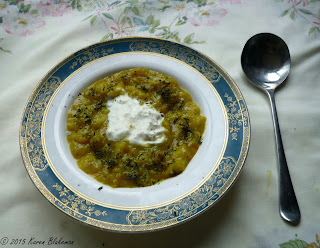For most of the 30 plus years we have been in this house we have had trees surrounding the back garden. When we moved in there were four sapling sycamores lining the footpath that runs along the back of the gardens in our terrace. Two of those were directly behind our boundary fence. As they grew they provided some welcome shade in hot summers and their autumn leaves helped add nutrients to our soil. Rather than gather up the fallen leaves and compost them we would leave them in situ, only moving those that were in danger of smothering the vegetables. By January/February they had usually rotted away.
 |
| Sycamore tree roots |
As the trees grew the council would come and prune them every year and we were able to manage the branches that overhung our garden. About 10 years ago, the council stopped pruning and the trees began to get out of hand. Just over a year ago it was obvious that they were causing serious damage: the trunks were breaking through fences, the roots were damaging paths and the road, and on our side their extensive root system (see the photo on the left) was a barrier to planting anything in the rear third of the garden. Also, the heavy shade when the trees were in leaf meant that it took a long time for the soil in half of the garden to warm up in spring.
Eventually, the council chopped down all four trees. Although welcomed in some respects, we realised that the environment in our garden was going to alter significantly; we spent much of last season trying to get a feel of how the light and temperature had changed and the effect this would have on our vegetable plot. We have already planted two trees - a damson and a cherry plum - but there is another spot that could benefit from the shade of a third fruit tree. The place was soon identified simply by standing in the garden for a short time in the midday sun and getting well and truly sun burnt! (We have not yet decided on which fruit tree to plant). As for planting crops at the back of the garden we have been using grow bags, partly because of the remaining tree roots that are close to the surface but also so that we could move the bags if we got the location wrong and the conditions weren't ideal.
That was the situation until a few days ago. Now, another tree has gone and this is a massive one. It is, or rather was, a sycamore at least 75ft high and in a garden a few doors down from us. The garden belongs to a cottage that has not been lived in for a couple of years but now it is up for sale. There is a possibility that the land might be sold to developers although, as we are on a flood plain, a successful planning application is far from guaranteed. Anyway, we assume that in order to make this desirable plot even more attractive the tree surgeons moved in and the tree is now gone.
 |
| Removal of the sycamore begins |
 |
| Tree surgeon at work |
 |
| Almost gone |
 |
| Gone |
It is sad to see such a magnificent tree go, although I suspect that the people living either side of the property are probably delighted. It did cast heavy shade over their gardens and houses. We shall miss it, and in particular we shall miss watching and listening to the myriad birds that used it. And, again, the environment in our garden is bound to change. But time to move on, and think of possibly planting some extra trees in our garden to compensate. Our neighbours can be reassured, though, that these will be of a more modest size.














































